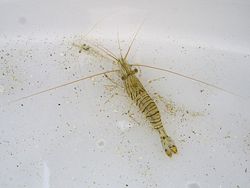| Palaemon | |
|---|---|
 | |
| Palaemon pacificus | |
 | |
| Palaemon elegans | |
| Scientific classification | |
| Kingdom: | Animalia |
| Phylum: | Arthropoda |
| Class: | Malacostraca |
| Order: | Decapoda |
| Suborder: | Pleocyemata |
| Infraorder: | Caridea |
| Family: | Palaemonidae |
| Genus: | Palaemon Weber, 1795 |
| Type species | |
| Palaemon adspersus | |
| Synonyms | |
List
| |
Palaemon is a genus of caridean shrimp in the family Palaemonidae. [2]
Some species, including Palaemon macrodactylus and Palaemon orientis , can inhabit fish ponds where they compete with fish for food and can therefore be considered pests. [3]